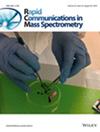Dissection of potential anti-osteoporosis mechanism of isopsoralen – a quality control marker in Psoraleae Fructus – by metabolite profiling and network pharmacology
Abstract
Rationale
Isopsoralen (ISO), a quality control marker (Q-marker) in Psoraleae Fructus, is proven to present an obvious anti-osteoporosis effect. Until now, the metabolism and anti-osteoporosis mechanisms of ISO have not been fully elucidated, greatly restricting its drug development.
Methods
The metabolites of ISO in rats were profiled by using ultrahigh-performance liquid chromatography coupled with time-of-flight mass spectrometry. The potential anti-osteoporosis mechanism of ISO in vivo was predicted by using network pharmacology.
Results
A total of 15 metabolites were characterized in rats after ingestion of ISO (20 mg/kg/day, by gavage), including 2 in plasma, 12 in urine, 6 in feces, 1 in heart, 3 in liver, 1 in spleen, 1 in lung, 3 in kidney, and 2 in brain. The pharmacology network results showed that ISO and its metabolites could regulate AKT1, SRC, NFKB1, EGFR, MAPK3, etc., involved in the prolactin signaling pathway, ErbB signaling pathway, thyroid hormone pathway, and PI3K-Akt signaling pathway.
Conclusions
This is the first time for revealing the in vivo metabolism features and potential anti-osteoporosis mechanism of ISO by metabolite profiling and network pharmacology, providing data for further verification of pharmacological mechanism.

 求助内容:
求助内容: 应助结果提醒方式:
应助结果提醒方式:


